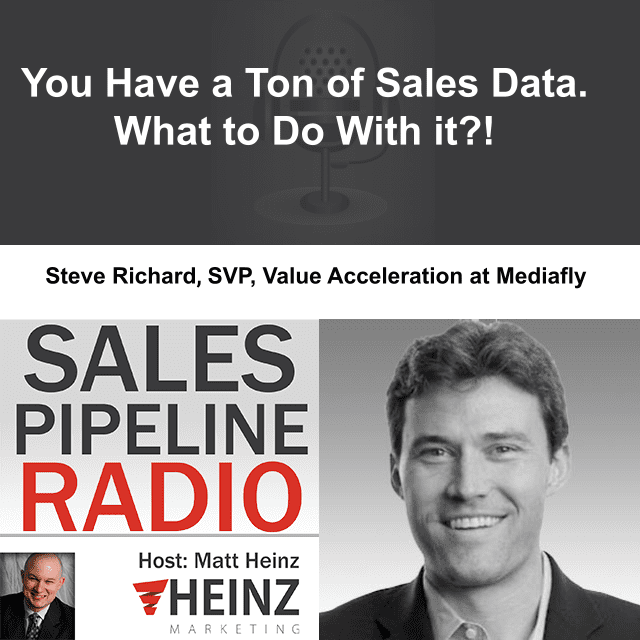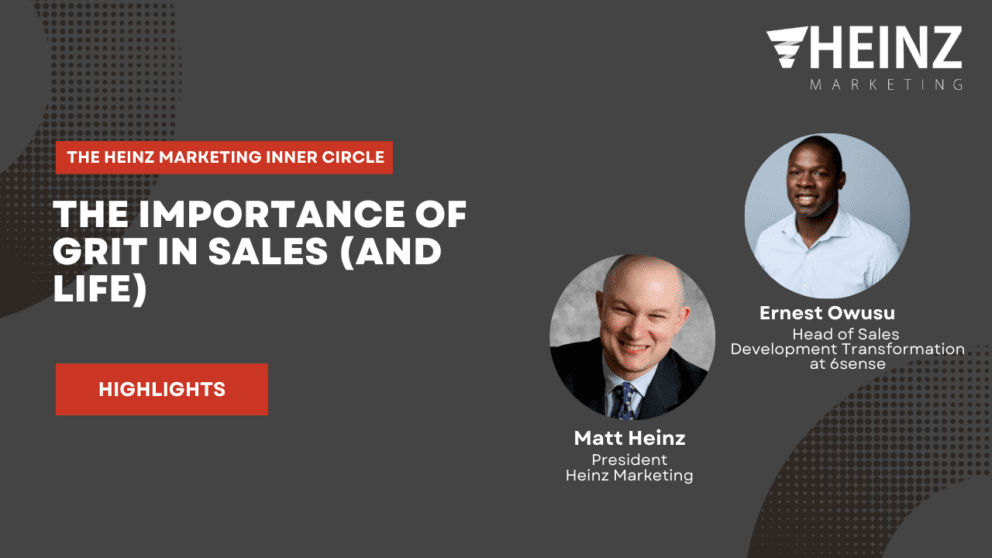Sales Pipeline Radio, Episode 324: Q & A with Steve Richard @srichardv

By Matt Heinz, President of Heinz Marketing
If you’re not already subscribed to Sales Pipeline Radio, or listening live every Thursday at 11:30 a.m Pacific on LinkedIn (also on demand) you can find the transcription and recording here on the blog every Monday morning. The show is less than 30 minutes, fast-paced and full of actionable advice, best practices and more for B2B sales & marketing professionals.
We cover a wide range of topics, with a focus on sales development and inside sales priorities. You can subscribe right at Sales Pipeline Radio and/or listen to full recordings of past shows everywhere you listen to podcasts! Spotify, iTunes, Blubrry, Google Play, iHeartRADIO, Stitcher and now on Amazon music. You can even ask Siri, Alexa and Google!
This week’s show is entitled, “You Have a Ton of Sales Data. What to Do With it?!“ and my guest is Steve Richard, Senior Vice President, Value Acceleration at Mediafly.
Tune in to hear more about:
- Sales intelligence and the increase in sales transparency
- The process of raising and training a sales rep
- Key tips for entrepreneurship
Listen in now for this and MORE, watch the video or read the transcript below:
Matt: Welcome everyone to another episode of sales pipeline radio. I’m your host, Matt Heinz. Thank you very much for joining us today. Excited to be here. First day of September, beginning of the fall, college football is back. It’s just a wonderful time. This begins the last four months of the year, and this is my favorite season. If you are listening or watching on demand. Thank you very much for doing so. We try to keep these tight 15, 20 minutes and talk about some of the best new ideas and insights around B2B sales and marketing. So thank you very much for downloading, subscribing in every episode of this podcast, back five plus years, and then moving forward on demand at salespipelineradio.com. Very excited to have him with us today, he’s the SVP of sales excellence at Media Fly, and he will not see this because he really is a very humble guy. He’s the smartest guy in most rooms and I’ve learned a ton from him about sales, sales intelligence over the years. Steve Richard, thanks for joining us today.
Steve: Geez. Thanks for that. Although that makes me feel awkward, but I don’t just sweat a lot by the way.
Matt: No, he doesn’t. So just real quick, if you are watching this, you see Steve is wearing a headband and if you follow Steve online, which I highly recommend you do, he does a lot of videos with himself in a headband. And this is not a schtick, this is not sort of some broetry version of a video. He literally is out running, and I don’t know how many of the rest of you, when you’re running, or you’re in the shower, you get ideas. So, he will stop running and record a video.
So usually he’s in his headband, even though I have no hair, I probably need one of those. Cause I sweat like a maniac when I’m working out. I think it would defeat the purpose of, a bald guy wears a headband. I don’t know. But anyway, that is the purpose behind the headband. And I joked earlier this week, I said, you know, you have to show up with the headband it’s part of your brand now. And you did. I’m very impressed.
Steve: Yeah, I’ll take it off now, but for everybody at home, there you go. So tip of the day on LinkedIn, if you connect with me on LinkedIn or follow you’ll get free sales tips every, almost every day.
Matt: That’s all right. Well thank you for coming on brand. And I miss seeing you out on the circuit and we used to get to see each other at some of the CEB events and other places. And you are always on top of what’s happening in sales and inside sales. Training and coaching you’ve run, you’ve founded and run and sold a number of businesses in the area of AI and data. And that’s how you end up at MediaFly as well. So definitely looking forward to just hearing and I’ll just give you the floor, what is, as we’re in the middle here of 2022, been an interesting year, lots of things going on. What are you seeing and hearing relative to training, coaching and intelligence today?
Steve: You got to look at sales productivity now, you can’t just hire more people, hire a way out of the challenges when there’s hiring freezes and those kinds of things. So the venture capitalists and private equity groups just doing a spreadsheet equation, just hire more sales people and we’re going to get this much more revenue – that doesn’t work anymore. So people are really focused on training, which is teaching people, something new, coaching, getting the people to do it. And we have the most transparency in sales that we’ve ever seen. It’s September 1st, 2022. This is the most transparent day in the history of sales. And then tomorrow will be more transparent. So we are finally seeing this advent of no more of this, we just do a steak dinner in closing kind of thing, but we actually have to sell the right way and people care about that and about elevating the profession.
Matt: So, at the same, I agree with you that we continue to see more and more transparency, at the same time, I think that there, you know, you hear this concept of dark social and the things that are happening that we’re not tracking today. I think those are both real things. So how do you think about this increase to transparency, accountability, and then how to still lean in on those things that may not be perfectly tracked, but can drive impact and performance.
Steve: Yeah, totally. I mean, we got acquired, I was the founder of Exec Vision acquired by MediaFly – all about content enablement, content engagement and knowing what the buyer’s doing. So just not to confuse the points, there is all the dark engagement of the buyer. I’m talking about transparency with the sellers and what they’re doing and the sellers have a lot more information than ever before as well.
What I’m seeing right now out there is people are really focused on defining what does good look like for the things that we can control. So I think we have to separate to your point, this kind of dark buyer’s journey that happens when we’re not around, there are a lot more things you can control than we give ourselves credit for. We have a lot more information in sales and marketing than we give ourselves credit for.
So let’s start with just what can we control? And then based on that, how do we define good along the way? And if we get everybody on a unified definition of good to start, that’s a really, really good place, even something as simple as how you construct a call, what is it? Everyone talks about discovery. So Matt, every week I’m asking sales and marketing leaders, what’s the one thing you want your reps doing better. Discovery pops out almost every time. Well, what does that mean to you? Because you might be in a company where you have seven different sales managers that all have a different definition of discovery. What does that look like? And then how can we optimize it so we can control as much as we can control?
Matt: I think this concept of the information that we now have available that we didn’t have before, some of it through artificial intelligence, some of it through, sort of intent signals in other places. It really is helping people answer more accurately the question that, I’m like, I’m a marketing guy. I’m not a sales guy, but I feel like since I’ve known you and worked with sales leaders, big question for many sales people is like, who do I call next, and why?
Steve: Right.
Matt: And so this new layer of intelligence really is a sea change in terms of helping reps, whether you’re an SDR or an AE and following up on deals to know where to spend your time. And that’s a huge component of productivity. Can you give a couple examples of where that is particularly useful for sales organizations today?
Steve: Yeah, absolutely. The mid funnel dead zone when people are dropping out. That’s a great example of where, if we have some more of those signals and intent around content or around what they’re going to be searching for, looking for. Or, what they’ve said in calls, in sales calls, which is what we’re all about with the transcription and the AI. That dead zone is key, where you have that initial engagement, you’ll have a scheduled call, first scheduled call with a buyer and they’re doing discovery and then they’re excited and they’re sending you the right vibes and then sales reps get happy ears, and then, they go off and what happens and the next scheduled call never happens. They can’t get anybody else engaged. Why? We have a lot more information now on why than we did before for all the things that I just described right there. So that is a big, big one.
Of course, top of funnel, without question, I’ve got a client, that’s doing things with intent, top of funnel and with very specific, so here’s kind of, terms of the cutting edge things people are doing. Some people would not consider this, but very specific offers for buyers, for prospects in the top of the funnel. We’re seeing that the expectation of buyers is the value of the initial appointment has to be higher than it was before. So the bar for me, taking my time to meet with you now is higher than it was before. So if we’re just simply going out there and trying to book demos, it probably isn’t getting it done like it did once upon a time.
Matt: Yeah. Yeah. I agree with that. We’re talking today on sales pipeline radio with Steve Richard, he’s the SVP of sales intelligence at MediaFly. He’s as far as I can tell, has founded and grown at least three companies, and I want to eventually get there towards the end, we’ll talk a little bit about the entrepreneurial journey and so what you’ve learned from that. But, we’re also talking today about sales rep productivity. And I think we can talk a lot about productivity best practices. What can you share to help companies see and identify productivity drains? What are some of the biggest culprits of keeping sales reps from being more productive in their role?
Steve: I’m going to give you something bizarre you wouldn’t expect me to say lack of cohesive culture. Given the fact that so many people are partially remote, fully remote, some in the office, some out of the office, that’s tough because if we’re all rowing the canoe in the same boat in the same direction, it’s a powerful force. But if we’ve got people that well, Tuesdays and Thursdays, these people come in and these people come in Wednesdays and Saturday, Fridays, it’s just, it’s really hard to have that cohesiveness of everyone being in the boat, rowing it in the same direction. And that’s especially pronounced for people who are doing outbound stuff or maybe a more transactional sales process. So that is a big, big barrier these days is, you used to have that organic interaction on the sales floor.
That’s gone. Even for people who are going back in the office, because when they go back in the office, they’ve socially distanced them and everything. It’s like you might as well be at home. You’re not really getting that experience.
Matt: Let’s dig into that a little bit. That’s a really fascinating answer to that question. As a lot of companies now are going more hybrid, more work from home, less like five days a week in the office. How is that impacting positively and negatively sales departments and cultures? How are the best companies leading through that and still seeing performance?
Steve: Yeah. Yeah. I mean, look, if you haven’t experienced tenure account executive, it’s probably going to look a little bit different as you’re going through this. But what I’m seeing right now is that people are doing the best they can with the online interactions they have and everything. But I’m seeing people go back to, this goes back to the transparency point of, we have to have an environment where we feel safe to fail. We have to have an environment where we feel safe to be vulnerable and to say, I don’t have all the answers and we’re going to look at sales metrics in a group setting or in a team setting, Zoom or Microsoft teams, or we’re going to play call recording as a group and then we’re going to score it individually to see how we calibrate. These are things that historically I only started that Exec Vision back in 2015.
If you said, “Hey, we’re going to have group call scoring calibration sessions, where you’re using a scorecard of five, nine questions and we’re going to do it all over zoom.” I’d be like, I don’t think that’s going to ever happen. Or maybe in 20, 30 years, it’s happening right now. And that’s how you’re getting people to bond based on the job they’re doing. The old Dan Pink autonomy mastery purpose. I mean, people have to feel that sense of autonomy. They have to feel that sense of mastering, of improving what they’re doing and at purpose and caring about what they’re doing. And if you don’t do that in this world, it’s real tough to get the productivity levels where you want them.
Matt: Another follow up on that. I think someone you and I both know pretty well, Max Altschuler, he runs Go to Market fund. I know you’re a limited partner with them as well.
Steve: Yep.
Matt: He posted something a couple days ago. He said, I don’t think work from home is good for people that are 10 years or less in their career. That being around, being in an office, being around other people, learning from them directly and indirectly is really, really important. I agree, but I operationally that is more of a challenge now, especially as people in the last couple years have hired people from all over the place. It’s just not physically possible to do that the way that it used to be. So given that, and we can argue pros and cons of Max’s point, if you’re interested, go find him, find that post there’s some fascinating answers and sort of rebuttal to his question. But, like, how do we best support junior employees? How do we best support and enable the inside sales reps, those junior SDRs that are still learning? How do we do that best in a remote environment?
Steve: Let me give you a real concrete one everyone can take away on this one. So there was old corporate executive board research that then was published in Harvard business, and if you Google HBR connected manager, you’ll find this article. And basically they did research that said, is it better for a sales manager, I think it was just any manager to coach that individual and that is their coach, and that’s it. Or is it better to have multiple coaches for that individual that are teaching them different things and have the manager sort of orchestrating all of it? And it turns out the answer is actually it takes a village to raise a child. So the productivity of any employee, especially sales employees are higher when you have multiple people involved in the training, coaching, education, development, whatever you want to call it, of that rep. And that’s something that I think a lot of companies get wrong, especially in this kind of virtual environment where it did feel like you were being raised by a village.
When I first started my career in, at CEB in 2002, I was fortunate I was in a floor of a hundred people and my backstory is if I wasn’t there, Matt, I would’ve failed. Because I was failing there, and I looked at the top, the leader board and I said, those five people are my new best friends. And I sat with them and I just observed what they were doing. I wrote it down, I did it. It took a village to raise a child. I interacted with managers that weren’t my managers, salespeople that were in the office that were normally in the field. Without that I wouldn’t be where I am today. So I think we have to be really, really cognizant of creating that village, raising children environment right now. And that goes into every aspect of what they’re doing. I’ll tell you a quick, real quick side story.
I was talking to a company today and they have their outbound function in Louisville, Kentucky. And I was kind of taken aback. I was like, really? I’ve never heard that. People never go there. And then at the end of it, they were like, yeah, I saw this really high performing outbound SDR team one time. And they would have a drink after the day in the bar in the basement. And everyone had that camaraderie and everything, he goes, I go to Louisville and I go like, hey everyone, it’s a round on me, come on, let’s go. And they all go but my commute so long, so they’re even in the office, but they’re like, yeah, but my commutes so long, it changes that whole fabric of how you develop as a sales professional that comes from all these mentors and all these people that you’ve had interacting with you in the past.
Matt: So if I’m hearing you right, what used to somewhat happen naturally, organically, maybe kind of osmosis. We now have to be very much more intentional about, we’re going, we have to really have a dedicated process and system. We can still enable people. We can still train people. We can still create community and culture, and you mentioned earlier sort of culture and cohesiveness.
Steve: Right.
Matt: So you’re saying we can do that. We just have to be way more intentional and prescriptive in how we do it.
Steve: That’s it. And if I go to people and ask a simple question, what’s the coaching plan for the rep? How are you tracking the coaching plan? Who’s working with them. What are they working with them on? Are they getting better? And they go, I don’t know. And these, by the way, are a lot of people who have conversation intelligence technologies or pipeline analytics technologies like MediaFly sells or other companies sell right? They have a lot of that data and information, but what they don’t have is a way of pulling it together to actually get Johnny and Susie better.
Matt: Yeah. Boy, there’s a lot of directions we can take this, but I love this discussion. I want to watch time and be cognizant of your time and sort of wrap this up in a minute, but shift gears to talk about starting and running a business. You’ve started and run at least three that I can tell. I don’t know whether you are done? I think people that are sort of geared like you probably never done doing that. I always think somewhere in your headband videos, probably the kernel of the next one. But, I think there’s a difference between having an idea and then going and executing on that. Right? Everyone’s got ideas, everyone, but the actual execution of that I think is what separates successful entrepreneurs from those that just have ideas. For people that are listening, that maybe the next Steve Richard, that may be the next entrepreneur to take this, their idea out and really grow it. What is some advice you would give people based on your experience so far?
Steve: One, be honest with yourselves, about what you know more about relative to other people, and then focus on that. It’s got to be something you care about. Two, just do it. It’s like Nike, just do it like David and I, when we founded VorSight, our appointment setting business. There was no business plan. There was no, we didn’t have any of that kind of stuff. We literally went to the bank and said, we want to open a bank account. They’re like, do you have a business license? No, what’s that? And then, I mean, you just pull the thread and before you know it you’re receiving checks from clients and you know, can always start with a professional service as opposed to trying to build the next greatest technology company with a hundred million investment. So just roll up your sleeves and do it and be honest with, if it’s creating value, then people are going to keep paying you for it. And if it’s not, then maybe you didn’t have the best idea.
Matt: Yeah. I think, I love that advice. And I just to double down on it, I started my business 14 years ago and I still tell people today if I would’ve waited until I was ready, there’s three things in my life, at least, that if I would’ve waited until I was ready, I never would’ve done. Get married, have kids, start a business. And I’ve told my wife this, I’m still not ready for any of those things!
Steve: Oh man, the amount of mistakes I’ve made along the way is unbelievable. But you also learn a ton from other people that you can show other folks that are out there. Matt, going back to your backstory because you and I met all those years ago, you were doing webinars and podcasts and content before it was cool before anybody even kind of knew what it was because you were just following your own personal heart of, you’re good at this stuff. I mean, that’s what it comes down to.
Matt: Well, I think it was also just, I tell people all the time, whether they want to be an entrepreneur or they’re just early in their career, is just start keeping a paper trail of how you think. Don’t worry about LinkedIn algorithms. Don’t worry about broetry, don’t worry about clicks and likes. Just start building a track record of how you think. And by doing that, not only does that hone your thinking and help other people see how you’re thinking. It also helps you become a better communicator. You write more, you speak more, you do more podcasts, you do more videos. Eventually you start getting, you hone your message. You hone your approach. It helps you hone your ideas. And I think that’s another place …
Steve: We’ve triggered a secret Matt that I’ve actually never told anybody. I mean, I’ve literally never told anybody this before. My little tips of the day on LinkedIn, I actually do them more for selfish reasons than for any others because now I have a really good documentation trail and actually the way that came about is hilarious, because I had Vorsight and then this Funnel Clarity and then, now ExecVision and MediaFly. All my content over the years, markers would take my blogs down that were really popular and performing well. And I got frustrated by that.
So now I just want to have it all in one place and the quickest and dirtiest way I can figure to do that is when I’m running, pulling out LinkedIn mobile app on my phone, which is free. I don’t have any editing or anything. It literally takes me 10 minutes to post at the most. And now I’ve got that idea out there in the future. And there’s so many times I’m scrolling through my own post to go aha! There is the one that I need to share with somebody because it’s going to help them.
Matt: Right. It’s raw, authentic. I think if you’d take more time to sort of polish it, would it make the idea better or would it mean you’re publishing less because it takes you more time as opposed to snippets of your ideas, that, I mean really all you’re doing, all any of us are doing with our content is trying to inspire people to customize that to their situation. I don’t have all the answers for me, let alone other people. But if this nugget helps you rethink something in your business, in your life, great! Don’t have to polish and edit that a thousand times. Love it. We could keep doing this forever, but I know you probably got to get out and go on another run or something. But Steve Richard, SVP of sales intelligence at MediaFly, it’s so great to see you and catch up with you. Thanks so much for joining us.
Steve: Good seeing you Matt. Take care everybody.
Matt: Thank you everyone for joining us. Appreciate everyone listening and watching. We’ll see you next week at 11:30 Pacific, 2:30 Eastern on Sales pipeline radio.
Listen to the Latest Episodes:






